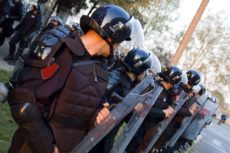Comply or Die – Trends in Modern Policing

Every time a police officer is killed in the line of duty, it makes local, if not national headlines. Though always shocking, the number of law enforcement fatalities has remained fairly steady over the years. According to the National Law Enforcement Officers Memorial Fund, 165 police officers were killed in the line of duty in 1917. Fatalities hit relative high points during alcohol prohibition in the 1920s, and in 1974 when 280 officers lost their lives. By 2000, this number had fallen to 162.
It is important to note this number includes all deaths, not just homicides. In 2013, the year for which the most recent data is available, 100 officers died. Of these deaths, more than half (57 percent) were the result of car accidents, motorcycle crashes, illness, and other unlikely events, not stabbings or gunshot wounds.
So we know every police officer that dies in the line of duty every year. Moreover, we know how. It may come as a surprise, however, that no such meticulous statistics are kept regarding civilian deaths at the hands of police. Federal authorities allow more than 17,000 law enforcement agencies to self-report officer-involved shootings each year.
Between 2007 and 2012, 753 police departments reported some 2,400 killings. The majority of law enforcement agencies didn’t report their numbers at all. A recent report by the Wall Street Journal found that the number of killings offered in the internal police reports from the 105 largest police departments were some 45 percent higher than the number reported by the FBI.
When taking all these numbers into account we can say two things with certainty.
- Being a police officer is not nearly as dangerous as it’s made out to be (in fact, your roofer is more likely to die putting shingles on your house, or your garbage man collecting trash, than a neighborhood cop patrolling the streets).
- Killings by police are significant and are likely under reported.
The deaths of Michael Brown and Eric Garner at the hands of police, the subsequent failure of grand juries to return an indictment against the officer involved, and waves of protests prompted President Obama to host a summit at the White House on the relations between police and the larger community.
As a result of this summit, the President called for a $263 million spending package aimed at reforming police departments around the country. He stated he would create a task force to recommend ways to improve relations between law enforcement agencies and the community:
“What I have confidence in is that if we do a better job of training our law enforcement to be sensitive to the concerns of minority communities, then overtime trust can be built.”
I’ve written elsewhere about the militarization of domestic police. I’m sorry to say, but suggesting “better training” in this case is akin to putting a band-aid on a severed leg and telling the person to “walk it off.”
The problem here is much deeper, much more fundamental than training. What we have witnessed in Ferguson, New York, and across the country reflects a deficiency with the underlying institutional structure of our police forces and the way the government provides defense and security.
As opposed to being accountable for their actions, police are shielded by “internal investigations” into wrongdoing and self-reporting. In effect, we trust the police to police themselves. While the police are empowered with their authority (and simultaneously trusted not to abuse it), they have been equipped with more powerful equipment, bigger weapons, and armored vehicles. As opposed to working to protect members of their community, police are trained to act as combatants in a war zone.
Questions regarding police activity and the actions taken by officers are often countered with claims about how officers fear for their lives and the dangers of the job. What we can see from the data mentioned above, however, is that this threat is not all it’s cracked up to be.
I am hopeful that the recent string of high-profile cases will illustrate the pervasive nature of this problem. At a minimum, bringing changes to current police tactics requires a massive shift in public opinion regarding what is acceptable and unacceptable for law enforcement. It’s time we seriously reconsider the mechanisms underlying our criminal justice system. If not, expect more of Ferguson, more of New York City, but repeated in cities and towns across the United States.


















